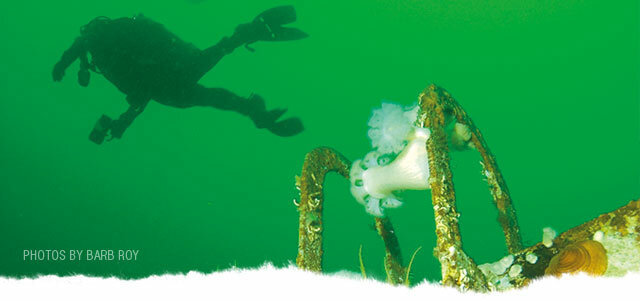 | ||
| GOING DEEPStory by Brandy Kiger Shreve The Salish Sea offers world-class diving.If you tire of the backcountry and your legs feel a little heavy after carrying the weight of your gear all winter, you might want to consider the ocean for your next adventure. Below the cold, gray-green expanse of the Salish Sea there is a vast wilderness waiting to be explored, and all you need is an open water SCUBA certification and some equipment to find it.While the Pacific Northwest may not be the first place you envision when you think of scuba diving, its waters offer divers an extraordinary opportunity to experience diving at its very best. “It’s world class,” said Ron Akeson, owner of Adventures Down Under in Bellingham. “Jacques Cousteau listed it as one of his top places to dive, second only to the Red Sea, and it consistently scores high marks across the board.” The mountainous terrain and alien-like flora and fauna found below the surface are world-renowned, and Akeson said depending on location, it’s not uncommon to encounter sea lions and wolf eels during a dive. “You don’t have to go very far to see the geography change, either,” Akeson said. One of the world’s largest inland seas, the Salish Sea is home to extraordinary geographical diversity and an astounding array of wildlife. “There are things down there that you’ve never seen before,” said Akeson. “It’s amazing, and much of the life you see here in the San Juans you’ll find in B.C. as well.” Shipwrecks littered throughout the waters off the coast of British Columbia also increase the draw for divers, as their complex surfaces provide the perfect foundation for wildlife to take hold and create stunning ecosystems to explore. “British Columbia has done a great job with sinking ships up there to create artificial reef systems,” said Karma Manley, an employee at Anacortes Diving. These cavernous vessels offer an extra degree of difficulty and wonder to your dive. “They’ve been really intentional about it,” said Akeson. “They’ve sunk destroyer escorts, a 400-foot liberty ship, a freighter and a tugboat to create this amazing underwater dive area.” The HMCS Cape Breton, a 442-foot former World War II victory ship is the world’s second largest diver-prepared artificial reef, and is located near Nanaimo on Vancouver Island. While the scuba tank, weight belt, buoyancy compensator and other gear might weigh you down on land, Akeson said, “Once you hit the water, you’re weightless. That weightless feeling is one of the coolest parts of diving.” NEED TO KNOW: Most rental shops require that you have a basic diver certification to rent equipment. Diving certification classes vary from outfitter to outfitter, but average around $400 (including books and gear). “It takes four evenings and a weekend to get certified in most cases,” Akeson said. “We offer one classroom session, three pool sessions and four open water dives on Saturday and Sunday to get you out there.” If you want a dry suit (which you will, since underwater temperatures hang near 40ºF), you will also need a dry suit certification. Visibility is more restricted than you might find in tropical dives. Typically 15 to 30 feet is the average visibility. X Where to rent your gear:
|